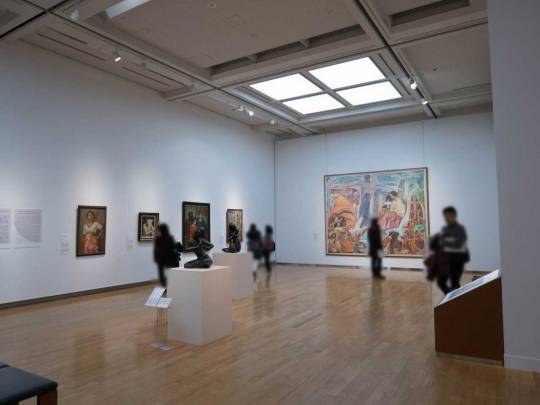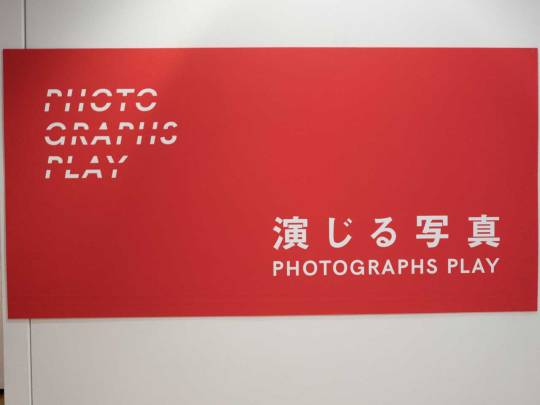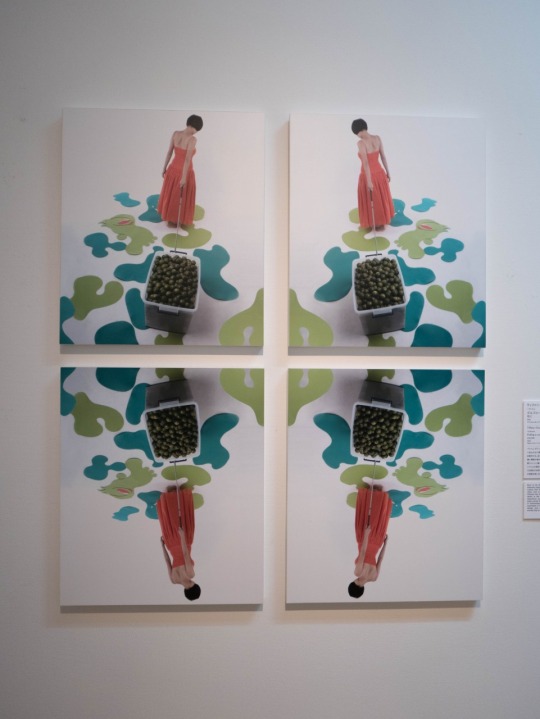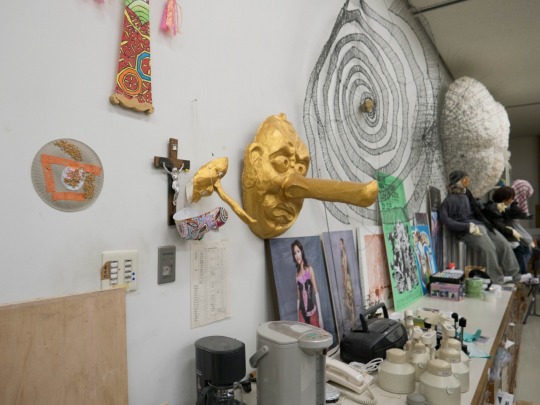#Ahmad Sadali
Explore tagged Tumblr posts
Text

Ahmad Sadali - Batang-batang merah bata dan sisa-sisa emas (Brick-red blocks and remnants of gold)
5 notes
·
View notes
Photo

Ahmad Sadali (Indonesian, 1924 – 1987)
Composition with Orange Background, 1968
oil on canvas 115 by 94.5 cm; 45 ¼ by 37 ¼ in.
2 notes
·
View notes
Text

"Symmetry in Violet", Ahmad Sadali, 1967. Oil on canvas,
2 notes
·
View notes
Photo

Ahmad Sadali - Desert Bandung, 1964
17 notes
·
View notes
Text
Barangkali inilah kongres darurat HMI pertama setelah didirikan oleh Lafran Pane dan kawan-kawannya pada tanggal 5 Februari 1947.
Ya, namanya kongres darurat, yang dilaksanakan di Yogyakarta pada bulan Desember tahun 1951. Entah apa penyebabnya. Mungkin saja karena pada tahun-tahun awal berdirinya HMI segalanya belum terlampau jelas.
Atau mungkin juga karena suasana revolusi Indonesia yang baru saja usai. Sehingga segala sesuatunya mesti berbenah. Termasuk bagaimana agar HMI semakin digandrungi oleh para mahasiswa yang ketika itu mulai menggeliat dan masuk ke universitas-universitas umum.
Di awal tahun 1950-an, HMI memang sudah tersebar di sejumlah kota-kota besar seperti Bandung, Surabaya, Jakarta, Dan tentu saja Yogyakarta sebagai ibukota historis HMI.
Deliar Noer dalam "Aku Bagian Ummat Aku Bagian Bangsa" menuliskan secara singkat bahwa adanya kongres darurat ini karena dikarenakan mengikuti perkembangan yang ada tentang konsolidasi organisasi, di samping perlunya kejelasan personalia dan struktur pimpinan pusat itu sendiri.
Memang pada kenyataannya, setelah didirikan oleh Lafran Pane, HMI dengan segera di bawah komando Ahmad Tirtosudiro. Namun ia sendiri kemudian aktif di Menwa dan berkarir di Angkatan Darat. Jadi ketika itu yang memegang tampuk pengurus besar HMI dalam catatan Deliar Noer adalah Asmin Nasution dan Dahlan Ranuwihardjo. Keduanya sendiri belum jelas, karena susunan pengurus HMI dibentuk oleh orang-orang pusat tanpa persetujuan cabang-cabang yang sudah ada beberapa buah.
Termasuk adanya wakil dari HMI Cabang Bandung yang dalam memori Deliar Noer diwakili oleh Achmad Sadali dari ITB. Kelak di kemudian hari ia menjadi salah satu tokoh seni rupa yang amat disegani di Indonesia.
Dalam kongres darurat HMI di Jogja itu salah satu keputusannya adalah pembuatan logo HMI yang akan menghias bendera dan rupa-rupa kegunaan lainnya, seperti dalam kalung kepengurusan dan logo surat.
Bayangan saya tentang keputusan adanya logo, secara aklamasi serempak diserahkan pada wakil cabang Bandung yang memang mempunyai orang-orang kompeten. Dan Achmad Sadali menurut kesaksian Deliar Noer sebagai perwakilan cabang Jakarta, ia tampak antusias menerimanya.
Agaknya dinamika di HMI tak berjalan lurus-lurus saja. Walaupun ketika kongres darurat di Jogja HMI Cabang Bandung yang diwakili Achmad Sadali sudah diserahi untuk membuat logo, nyatanya dalam kongres HMI di Jakarta pada bulan September 1953, keputusan itu kembali digugat.
Terutama dari cabang Jakarta yang berpendapat bahwa keputusan itu bukan berarti mutlak harus diterima tanpa syarat. Tentu saja hal ini membikin sewot cabang Bandung.
Achmad Sadali menurut Deliar Noer dalam memoarnya tersebut emosi tinggi. Karena ia merasa bahwa yang berhak membuat rencana logo HMI itu adalah cabang Bandung, bukan yang lain.
Seusai dengan ketetapan kongres darurat di Jogja. Bahkan, mungkin semangat anak muda yang meledak-ledak, Achmad Sadali yang pada waktu itu berusia 29 tahun dan masih berstatus mahasiswa seni rupa sampai mengancam akan keluar dari HMI. Apabila rencana logo dari HMI Cabang Bandung tidak terima.
Rupanya manjur juga jurus yang dikeluarkan oleh Achmad Sadali. Hahahah. Emang keren nih rakanda senior kita. Lahul Fatihah
0 notes
Photo

Ahmad Sadali (1924-1987) Emas Tersisa (Traces of Gold), 1972
64 notes
·
View notes
Text
Reframing Modernism (Gallery 3)
Gallery 1
Gallery 2
Fernando Zobel
In 1951, Zobel returned to Manila after attending Harvard University. Though he had no formal training in art, he soon joined the ranks of young artists such as Hernando R Ocampo and Cesar Legaspi, who were forerunners of a new era of modern art in the Philippines.
Painted in 1952, Carroza is a partially abstract portrayal of folk subject matter, unified by a warm ochre background, bold black lines and a flattened, symmetrical composition. Zobel continued to use line and a limited colour palette in his works, but he eventually abandoned depicting recognisable subject matter altogether and ventured into full abstraction with his Saetas series in 1957.
This series was conceived following Zobel’s artist residency in the United States and a period of intense experimentation with non-objective painting, which lasted from 1954 to 1957. He declared movement the subject of Saetas, with fields of colour finished with expressive lines drawn using syringed of oil paint. Zobel’s works of this series look like they were made spontaneously, but he was known for actually sketching intensively before arriving at a work’s final composition.
A decade later, he developed a more precise approach to the use of line and atmospheric colour in works such as Conversation with Lee from his Dialogos series.
Consider this artist alongside:
Nicolas de Staël, Ahmad Sadali

(Above)
Fernando Zobel
(b. 1924, Manila, Philippines; d. 1984, Rome, Italy)
Conversation with Lee
1967
Oil on canvas
Collection of Lopez Memorial Museum

(Above, left)
Fernando Zobel
(b. 1924, Manila, Philippines; d. 1984, Rome, Italy)
Saeta no. 36
1957
Oil on canvas
Gift of Roger Keyes
Collection of Ateneo Art Galllery
(Above, right)
Fernando Zobel
(b. 1924, Manila, Philippines; d. 1984, Rome, Italy)
Saeta no. 37
1957
Oil on lawanit board
Gift of the artist
Collection of Ateneo Art Gallery
Pablo Picasso
In this composition, the cubistic, fractured forms of a cat and a rooster create a macabre still-life. Behind them, a knife rests on the rim of a cup, reinforcing the sense of menace. The use of grisaille (painting entirely in tones of grey) in this work is similar to some of Picasso’s iconic anti-war paintings, such as Guernica of 1937, and Massacre in Korea of 1951. Picasso often used this palette for paintings evoking anxiety and violence: in this case, the everyday violence of predator and prey. In the Western tradition, the still-life was used as a reminder of the transience of human existence, and the objects could carry symbolic meaning. Picasso engages with the history of still-life in this image of death.
A tireless innovator, Picasso continually reinvented his work in several different media: painting, printmaking, sculpture and ceramics. In his early career, he was a pioneer of Cubism alongside Georges Braque, developing a radical new way of painting: forms were reduced to geometry, and multiple points of view were compressed into a single perspective. However, Picasso’s work was never fixed with a single style, and he also embraced representational and symbolic subjects. In his late work, he would show greater spontaneity and expressiveness.
Picasso’s relentless creativity and desire for change have made his work among the most important and influential of any modern artist.

(Above)
Pablo Picasso
(b. 1881, Málaga, Spain; d. 1973, Mougins, France)
The Cat and the Rooster
1953
Oil on canvas
Donated by Louise and Michel Leiris, 1984
Collection of Centre Pompidou, Paris
Musée national d’art moderne/ Centre de création industrielle
Latiff Mohidin
Latiff painted the Pago-Pago series between 1964 and 1969. In it, he experiments with a vocabulary of forms drawn from natural, cultural and historical motifs such as pagodas, stupas, shells and leaves.
Before embarking on making this series, he was in Berlin from 1960 to 1964. He took rigorous plein air (open air) and still-life drawing classes, and encountered German Expressionism, which had emerged during the 1900s to 1920s and was being re-examined in the post-war era. Latiff also travelled extensively throughout Southeast Asia. These experiences influenced the Pago-Pago series: its organic forms allude to the cultural and the natural world of Southeast Asia, while its gestural brushwork reflects German Expressionism.
Malam Merah and Pago-Pago 69 (Metamorphosis) are emblematic of this series. Malam Merah has dynamic forms, rich colour and animated brushwork, while Pago-Pago 69 (Metamorphosis) has a translucent quality created by layering and mixing pigments with varnish. The latter demonstrates his confident grasp of materials and versatility as an artist.
Consider this artist alongside:
Jean-Michel Atlan

(Above)
Latiff Mohidin
(b. 1941, Negeri Sembilan, Malaysia)
Untitled, Pago-Pago Series
1965
Oil on masonite board
Collection of Too Hing Yeap and Yoong Sin Min

(Above)
Latiff Mohidin
(b. 1941, Negeri Sembilan, Malaysia)
Pago-Pago No. 2, Pago-Pago Series
1965
Oil on canvas
Collection of Zain Azahari

(Above)
Latiff Mohidin
(b. 1941, Negeri Sembilan, Malaysia)
Malam Merah (Red Night), Pago-Pago Series
1968
Oil on canvas
Collection of Zain Azahari
CoBrA
The CoBrA movement was founded in Paris in 1948 and dissolved in Brussels n 1951. Its name was based on the first letters of the places where its members lived: Copenhagen, Brussels and Amsterdam. The movement sought to return to a more spontaneous and less rational form of creativity, drawing on a range of sources, including the magic and symbolism of Nordic popular mythology and the expressive tendencies of children’s art. This was based on a humanist philosophy that emerged from the trauma of World War II, which privileged authentic expression, In doing so, they offered a radical, alternative way of approaching painting. Their approach rejected the convention of categorising painting as either abstract or figurative, as it had elements of both.
The group comprised a number of northern European artists and poets including Asger Jorn, Karel Appel, Carl-Henning Pedersen, Corneille Beverloo, Joseph Noiret, Constant Niewenhuys and Christian Dotremont. Advocating physical spontaneity and vitality, its members produced “four-handed works”, each using the combined creative energy of two artists to create unique collaborative pieces of great poetry and plasticity. While short-lived, CoBrA’s radical philosophy attracted a number of major artists from different disciplines, and had a lasting influence on the past-war art scene.
Consider this artist alongside:
André Masson, Jean-Michel Atlan, Bagyi Aung Soe

(Above)
Asger Oluf Jorgensen, known as Asger Jorn
(b. 1914, Vejrum, Denmark; d. 1973, Aarhus, Denmark)
Kyotosmorama
1969-1970
Oil on canvas
Purchased by the French government, 1971
Acquired 1976
Collection of Centre Pompidou, Paris
Musée national d’art moderne/ Centre de création industrielle

(Above)
Carl-Henning Pedersen
(b. 1913, Copenhagen, Denmark; d. 2007, Frederiksberg, Denmark)
Yellow Horse
1941
Oil on canvas
Donated by Mme Sidsel Ramson, 2012
Collection of Centre Pompidou, Paris
Musée national d’art moderne/ Centre de création industrielle
And of course, the endnote:
Endnote Reframing Modernism shows the various paths, proposals and approaches to modern art taken by 51 artists working in different geographical, historical and social contexts. While there may be parallels across the works, the exhibition reveals above all the singularity of individual artistic practice in relation to modernism: the diversity of the artists and the nuances of each artist’s approach. Given this diversity, the conventional understanding of modernism as a simple story of influence from Europe and America cannot be sustained. A dynamic and creative exchange, occurring at multiple centres, emerges instead. Our understanding of modernism is continually being rewritten and contested: Reframing Modernism hopes to open up this story further.
Finally after more than a year, Gallery 3 is up. Looking through the photos I’ve taken, I can still feel what I remember feeling at the exhibition itself. Art can be truly remarkable in its variety and scope in terms of the different styles and disciplines, different reasons for making art, different emotions that goes into the pieces and the feelings they invoke in us the viewer, etc, etc.… art is as varied as the artists that make art.
I’m not a “formally trained” art student, and my knowledge of the various art movements is superficial at best; I am also totally unfamiliar with Modernism in art, and pretty much know nothing about analysing art, which is why one of the things I really liked about the exhibition was the artist bio which explain the backgrounds of the different artists, their histories, ideals and inspirations, characteristics and themes that run through their art, the social and political context at that time which influenced their art, etc. It really helped me have a deeper understanding of the paintings, such that they are no longer just objects of art, but become tiny snippets of history frozen in time, a sliver of the artist’s world seen through the artist’s lens, and each with their complex stories.
It made me realise more than ever that artists are not hermits who only focus on their own works, and there are no boundaries or walls in art. Art diverges and converges in such complex ways that we cannot predict and I think it was really amazing to be able to see this at this exhibition. My greatest takeaway from this exhibition, I think, would be the realisation that art is, at the same time, a relic of preserved history and alive and ongoing; I’m glad to be able to witness a small part of it.
0 notes
Text
冬のおとなミュージアム「超★現実」あなたの知らないバスツアー ~1.福岡アジア美術館編~
もう開催から2ヶ月近いのですが、2017/01/28に行われた福岡市美術館・福岡アジア美術館・福岡市博物館の3館連携企画「冬のおとなミュージアム 超★現実」の関連プログラム、3館をマイクロバスでまわり裏側にも潜入する「あなたの知らないバスツアー」に応募して見事当選。「広報サポーター」として取材してきましたので、その話を3回に分けて書いて行こうと思います(簡単にはTwitterで #あなたの知らないバスツアー というタグつけて疑似実況していました)。

今回は第1回、中洲川端・博多リバレインにある福岡アジア美術館での話です。

2.福岡市美術館編
3.福岡市博物館編
※以下、特記なければ写真の作品・展示品は福岡アジア美術館の所蔵品です。 作品・展示品の撮影/SNS・Webへの掲載許可済(福岡アジア美術館・福岡市博物館は一部例外があるものの、常設展の撮影はフラッシュ・三脚使用禁止で認められています。)
福岡市美術館・福岡アジア美術館・福岡市博物館の3館が連携して共通のテーマで企画展などを行う「冬のおとなミュージアム」。今年で3回目でテーマは「超★現実」(ちなみに一昨年のテーマは「LOVE/愛」 、 去年が「秘密―かくす・のぞく・あばく」 )。
まず最初に訪れたのは福岡アジア美術館(Fukuoka Asian Art Museum 通称:あじび、FAAM)。7階入口右手のアジアの地図(撮影する暇がなかった)を前に、あじびの学芸員さんからあじびについて簡単な解説からスタート。
あじびは「アジア」を「23の国と地域」と定義していて、22の国と地域の19世紀から現在までの作品を所蔵しているとのこと。6人のスタッフで調査しているそうで、凄いですね!
また、あじびが複合型商業施設「博多リバレイン」にあるのは、「生活しながらアートを見る」都市型の美術館にしたいという思いからなのだそうです。確かに天神や博多駅から「ふらっと」行けますよね。
と、あじび本体についての解説が終わったら、いわゆる「平常展」になるアジアギャラリーへそのまま移動し、ギャラリートークがスタート。アジアギャラリーについてのごく簡単な解説の後、ギャラリー内のコレクション展の1つ「アニッシュ・カプーアとインドのカタチ」の解説がはじまりました。
アニッシュ・カプーアとインドのカタチ

アジアギャラリーで5/9まで行われている、福岡市美術館所蔵のアニッシュ・カプーア Anish Kapoor の作品と福岡アジア美術館所蔵のインド現代美術作品群の特集展、「アニッシュ・カプーアとインドのカタチ」。
インド出身でイギリスを拠点として活動するアニッシュ・カプーアは、ロンドンオリンピックのシンボルタワー「アルセロール・ミッタル・オービット 」の設計を担当したことなどで知られているそうです。
アニッシュ・カプーア「虚ろなる母」(福岡市美術館蔵)

福岡市美術館の常設展示室(2階)の入口に長い間展示されていた作品。市美で展示されていたときは茶色のタイルの壁と大きな窓が背景でしたが、あじびでは真っ白な背景。表面の青と内側の「虚ろ」が強調される感(学芸員さんの解説でも、「あじびでの展示のほうが作者の意図に近いと思われる」とのこと)。内側は奥に行くほど暗くなっていて吸い込まれそうになる感じでした。

アニッシュ・カプーア「無題(Ⅰ)」(1988)(左)、「無題(Ⅱ)」(1988)(右)(共に福岡市美術館蔵)

対するあじびコレクションによる「インドのかたち」も紹介したいところなのですが、写真を撮り忘れるという痛恨のミス(人が多く、撮るタイミングがつかめなかったのもあるけど)。タントラ画がよかったんですが、すみません……。
演じる写真(「冬のおとなミュージアム」企画展)
続いて3/21まで行われている冬のおとなミュージアム「超★現実」の企画展、「演じる写真」の展示解説。

「演じる写真」では、作者自身が写真に被写体として登場している写真や現実には存在しない世界をつくりあげた写真を選んで展示しているそうです。ちなみに 「写真」をテーマにしたのは、企画ギャラリーで行われている特別展が篠山紀信展で、写真に興味がある来館者が多いだろうからとのこと。
以下、学芸員さんによる解説があったものを紹介。
プラディープ・タラワッタ 「道景(ロードスケープ)」 Pradeep Thalawatta (Sri Lanka) “Roadscape“ (2012(2014))

スリランカのプラディープ・タラワッタの作品。スリランカは2009年まで宗教紛争があったそうなのですが、この写真では仏教徒である作者が、紛争で一部壊れたままになった街並みに、ヒンドゥー教の聖域(寺)を表す赤と白の縦縞の服を着て、見ざる聞かざる言わざる(と思われる)の仕草をして佇んでいるという不思議な作品。
少し脱線しますが、あじびでは解説としてキャプションに鑑賞の「ヒント」を載せているとのこと。海外からの観覧者も多いため英語のキャプションも併記しているほか、中国語・韓国語のキャプションも用意しているそうです。
この作品は、上に述べた知識が「ヒント」としてあるとないとでは、見方が全然変わりますね。
チー・パン「太陽」Chi Peng(China) “Apollo in Transit” (2004)

チー・パンの「太陽」には、「天安門を思わせる赤い壁」���前に全裸で走る作者が何人も写っています。

よく見ると上のほうについている水の粒に、全裸の男(作者?)が写りこんでいたり、ベンチに座る人々も女装した男性や目が見えないことを匂わす人など中国の「メインストリームの外れにいる人たち」が写っているという、これまた意味が深そうな写真です。
ニッキー・リー「ヒップホップ・プロジェクト(19)」Nikki S. Lee(South Korea) “The Hip Hop Project(19)“ (2001)

2000年前後にアメリカで撮影された 、いくつかのコミュニティの一員になりきった ニッキー・リー(上の写真中央)の作品群は、同じくアメリカで2009年に撮影されたチェン・チンヤオの作品群と向かい合うように展示。
チェン・チンヤオ「I ♥ NY Series」ル・ブフ・ア・ラ・モード、アッパーイーストサイド Chen Ching-Yao(Taiwan) “I ♥ NY Series“ Le Bouef a la Mode, Upper East Side (2009)

NYにある各国のレストランでその国の衣装で扮装したチェン・チンヤオ (ちなみに上の写真右から2番目) の一見おもしろい・可笑しな作品群。
しかし学芸員さんの言葉を(大まかに)借りると「ニッキー・リーの作品にあった『周囲に溶け込もうとする涙ぐましい努力』が見られず」、二人の作品群を一緒に展示したこのコーナーは「コミュニティに溶け込もうとした2000年前後、溶け込まなくてもよくなった2000年代後半」という見方ができます。
なお同じエリアにはチェン・チンヤオが2012年に福岡で撮った「レストラン・プロジェクト in 福岡」があり、福岡に溶け込もうとしていない作者の姿がみれます。
自由時間(私の好きなあじびの作品)
と、ギャラリートークが終わると、少しの間自由時間が設けられました。その間、ギャラリートークで紹介がなかったアジアギャラリーの他の作品を見ていました。
あじびのアジアギャラリーは展示替えが大胆で、2、3に一回行くと大きくラインナップが変わっています。
今回はあじびのコレクションの中でも個人的お気に入りの作品が数点展示されていたので、この場���借りてご紹介したいと思います。
キエン・イムスィリ 音楽のリズム Khien Yimsiri (Thailand) “Musical Rhythm“ (1949)

地域・時代問わず仏像好きなのですが、初めて見たときから「仏像っぽい」と思っていました。キャプションを読むと
スコータイ朝(13~15世紀)の仏像表現を取り込むことで、西洋的な写実彫刻を乗り越えた点が高く評価された。
とあり、「ああー、そうかー」と納得する次第。
像が描く軽やかな曲線が美しいと思います。特に立てた指先が好きです。
アハマッド・サダリ「平面のなごりと金色の棒」 Ahmad Sadali (Indonesia) Plane Remnants and Golden Bars (1977)

青と金のコントラストが美しい作品。
キム・チャンヨル(金昌烈)「水滴」 Kim Tschang-yeul (South Korea) “Waterdrops“ (1977)

キャンバスにとてもリアルな水滴が無数に描かれた作品。福岡市美術館にあったときから好きでした。これはぜひ実物を見て欲しいです。
--
ちなみにあじびで個人的に一番好きな作品は、人をかなり選ぶと思うのですがハァ・ユンチャン(何雲晶, He Yunchang)の「相撲―1対100」(Wrestling: One and One Hundred)という、アーティスト本人が男100人相手に一人で笛を合図に相撲を取り続けるという白黒の30分の映像作品。最後10分、もう限界で投げられるだけになりながらも立ち上がり続ける作者の姿が感情を揺さぶります。直近の展示は2016年のコレクション展「スポーツの祭典―めざせ金メダル」だったかと。
あと最近観た中だとチュオン・タンの「平和の母」という迷彩柄の布を何十枚も重ねて美しいドレスの���うにした作品も好きです。
キッズスペース

アジアギャラリーを出たら、8階に向かったのですがその途中の踊り場からアジアギャラリー出口近くのキッズスペースが望めたので、このキッズスペースについての解説。
実は「演じる写真」の最後の方に作品が複数展示されていたティファニー・チュンが手がけたそう。確かに色使いが展示されていたティファニー・チュンの作品と似ている気がします。
ティファニー・チュン「ゴルフコースでライムの果実の箱を引く」Tiffany Chung(Vietnam) “Pulling a crate full of limes in golf course“ (2004)

ちなみにこの作品、バスツアーの前の週に行われたギャラリートークでは解説があって、「ベトナムに近年多数つくられたゴルフ場」を思わせる緑の模様の上を、「ベトナムでよくつくられるライムの実」が入った箱を引いているという、綺麗なだけではない作品となっています。
交流スタジオ
次は8階の交流ギャラリー横の交流スタジオへ。
交流スタジオはあじびで行われている「レジデンス・プログラム」という海外のアーティストや研究者などを招いてあじびに滞在してもらい制作や研究、そして交流プログラムを行ってもらうという企画で、アーティストたちが製作等をする現場となっています。

壁面や周囲にはアーティストがつくったものやワークショップで作られた作品が雑然と飾ってありました。

ちなみに昨年12月まで滞在していた台湾のアーティスト、ロー・イーチュンが製作する作品のために、バナナの皮を某クレープ屋から1000本ほど提供をうけ、それを乾かしてアイロンをかけてのばすという気の遠くなるような作業もこの部屋で行われていたそうです。
バックヤードツアー
そしていよいよバックヤードへ。写真載せないけれど収蔵庫の前まできました(さすがに中には入れないです)!
バックヤードで目立ったのは作品を運ぶための大形のエレベーター��3館最大の5000kgまで運べる本当に大きなエレベーターでした! でもこれでも運べなかった作品(梱包含めると作品はさらに大きくなる)は、ギリギリ学芸員さんたちの工夫でなんとか作品(ちなみに運べなかったのは回転寿司の回る部分を使う作品、結局2つに分解して運んだとか)があるそう。

これに乗って某所までいって、バスに乗り、次の目的地「福岡市美術館」へ移動しました。
キリがいいので、福岡市美術館編に続きます。
0 notes
Photo

Ahmad Sadali (1924 - 1987) - Batang-batang merah bata dan sisa-sisa emas (Brick-red blocks and remnants of gold), 1979. Oil on canvas / 98 by 98 cm; 38 by 38 in.
26 notes
·
View notes
Photo

Ahmad Sadali, b. 1924, d. 1987 Self Portrait Indonesia (undated) Acrylic on Canvas 84 x 65 cm. (33.1 x 25.6 in.) [Source]
The Jakarta Post says:
Sadali was a pioneer of Indonesia's modern abstract arts who showed his own version of Indonesia's cultures through work greatly influenced by Islamic values...
Sadali was born in Garut, West Java, on July 29, 1924. He studied at the Bandung Institute of Technology (ITB) under Ries Mulder's guidance. He received a scholarship to study at the Department of Fine Arts at the State University of Iowa, and the Art Student League in New York.
Upon his return, he started to develop his abstract art skill that was combined with themes of spirituality.
Sadali was also a muralist, designer and an academic. He was a fine-art professor at ITB and an initiator of the establishment of Bandung Islamic University (Unisba). He received the National Art Award from the government in 1972.
2 notes
·
View notes
Photo

AHMAD SADALI (Indonesian, 1924-1987)
Batang Melingkar dan Horizontal (Coiling and Horizontal Planes) 1984 mixed media on paper 44 x 40 cm (17 5/16 x 15 3/4 in)
Private Collection, Indonesia
Modern and Contemporary Art / © Bonhams
5 notes
·
View notes
Photo

Ahmad Sadali Emas Tersisa (Traces of Gold), 1972
2 notes
·
View notes
Photo

Ahmad Sadali (Indonesian, 1924-1987), Untitled, 1972. Oil on canvas, 80 x 65 cm.
108 notes
·
View notes


